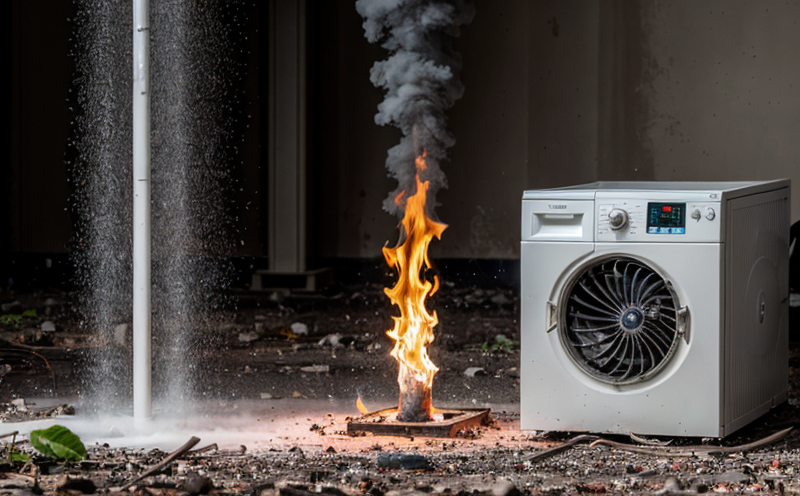IEC 60068-2-64 Random Vibration Environmental Stress Testing of Battery Packs
The IEC 60068-2-64 standard is a critical component in the environmental stress testing protocol for battery packs. This international standard specifies the procedures and criteria for assessing the performance of electronic, electrical, and mechanical equipment under random vibration conditions. It aims to ensure that products are robust enough to withstand the harsh environmental stresses they may encounter during their lifecycle.
Random vibration testing is a form of non-deterministic excitation where the amplitude and frequency components can vary randomly within specified limits. This type of testing mimics real-world scenarios such as transportation, handling, or installation processes that might expose battery packs to unpredictable mechanical stress. The standard provides a standardized method for subjecting batteries to these vibrations, ensuring consistent and reliable test results across different manufacturers.
The testing process typically involves placing the battery pack on a vibration table, which is capable of generating random vibrations over a specified frequency range (usually from 10 Hz to 2 kHz). The amplitude of these vibrations can vary depending on the specific requirements set out in IEC 60068-2-64. During the test, engineers monitor various parameters such as temperature, voltage, and current levels within the battery pack to assess its structural integrity and electrical performance.
The significance of this testing cannot be overstated. By subjecting batteries to controlled random vibrations, manufacturers can identify potential weaknesses or design flaws early in the development process. This proactive approach helps prevent costly product failures later on, enhances overall quality assurance, and ensures compliance with international safety standards.
In addition to enhancing product reliability, IEC 60068-2-64 testing also contributes significantly to environmental sustainability efforts by promoting more robust and durable battery designs. These improvements lead to extended product lifecycles, reduced waste generation, and lower resource consumption throughout the supply chain.
- Reduces material usage through optimized design
- Promotes longer-lasting products requiring fewer replacements
- Minimizes e-waste by extending battery life cycles
- Encourages sustainable manufacturing practices
Beyond mere compliance, this testing enhances customer satisfaction by delivering higher-quality products that perform reliably under diverse conditions. For quality managers and procurement officers, ensuring adherence to such standards demonstrates commitment to excellence and sets a benchmark for industry best practices.
To summarize, the IEC 60068-2-64 random vibration test is essential for any organization involved in battery pack manufacturing or testing. It provides valuable insights into how well your products can withstand environmental stresses while contributing positively towards sustainability goals.
Why It Matters
The importance of IEC 60068-2-64 random vibration testing cannot be overstated, especially for companies operating within the electronics and automotive sectors. This form of environmental stress testing plays a crucial role in safeguarding product integrity by subjecting batteries to realistic mechanical stress conditions that they might encounter during transportation or installation.
One key reason why this type of testing is so critical lies in its ability to highlight potential weaknesses early in the development process. By identifying issues before full-scale production begins, manufacturers can make necessary adjustments and improvements, thereby avoiding costly recalls or product failures post-launch. This not only protects brand reputation but also ensures customer satisfaction by delivering reliable products.
Another significant advantage of conducting IEC 60068-2-64 tests is that it helps maintain regulatory compliance. Many regions have stringent regulations governing the safety and performance standards for electronic devices containing batteries. Adhering to these guidelines through rigorous testing ensures that your products meet legal requirements, avoiding potential fines or market restrictions.
In addition to enhancing product reliability and meeting regulatory expectations, random vibration tests also play an integral part in improving environmental sustainability efforts. By ensuring robust construction, manufacturers contribute to reducing waste generation by extending battery life cycles. Longer-lasting products mean fewer replacements are needed, ultimately leading to lower resource consumption throughout the supply chain.
Moreover, this testing contributes significantly to customer satisfaction by delivering higher-quality products that perform reliably under diverse conditions. For quality managers and procurement officers responsible for ensuring consistent product performance across different environments, meeting these standards sets a benchmark for industry best practices.
Customer Impact and Satisfaction
The implementation of IEC 60068-2-64 random vibration testing has far-reaching implications beyond just technical specifications; it significantly impacts customer experience and satisfaction. When customers receive products that have undergone thorough environmental stress testing, they can expect enhanced durability and reliability in their daily use.
Manufacturers who invest in these tests demonstrate a commitment to quality assurance, which builds trust with consumers. This level of dedication translates directly into increased brand loyalty and positive reviews from satisfied customers. Furthermore, successful completion of such rigorous tests often results in certifications that signal superior product performance, adding value to the end-user experience.
From an economic perspective, investing in IEC 60068-2-64 testing can lead to cost savings for both manufacturers and consumers alike. By preventing early failures due to unforeseen environmental stresses, companies minimize warranty claims and service costs associated with repairing or replacing defective units. Consumers benefit from purchasing durable goods that last longer without compromising on safety standards.
Another aspect where customer satisfaction is enhanced pertains to safety considerations. Random vibration tests help identify any potential risks related to structural integrity under extreme conditions, ensuring the protection of both users and bystanders. This heightened sense of security fosters greater confidence among purchasers, making them more likely to recommend your products positively.
The cumulative effect of these factors contributes substantially toward achieving higher levels of customer satisfaction across various sectors including automotive, electronics manufacturing, and consumer goods industries. As a result, manufacturers who prioritize IEC 60068-2-64 compliance stand out favorably both in terms of reputation and market standing.





